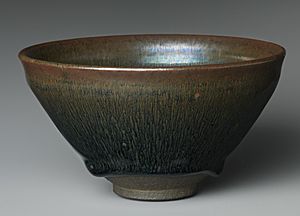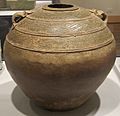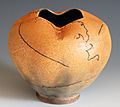Stoneware facts for kids

Stoneware is a broad term for pottery or other ceramics fired at a relatively high temperature. It may or may not be glazed. It was developed after earthenware and before porcelain. Stoneware can be made from a much wider range of clays than porcelain.
Historically, reaching high temperatures was a big challenge. Lower temperatures were used for a long time. Earthenware can be fired as low as 600°C. This was done in primitive pit firing, but 800 °C (1,470 °F) to 1,100 °C (2,010 °F) was more typical.
As a rough guide, modern earthenwares are normally fired in a kiln at temperatures in the range of about 1,000°C (1,830 °F) to 1,200 °C (2,190 °F); stonewares at between about 1,100 °C (2,010 °F) to 1,300 °C (2,370 °F); and porcelains at between about 1,200 °C (2,190 °F) to 1,400 °C (2,550 °F).
Images for kids
-
Glazed Chinese stoneware storage jar from the Han Dynasty
-
Chinese Yixing teapot, Qing dynasty, c. 1765–1835, with painted slip.
-
Wedgwood jasperware salt cellar with The Dancing Hours, 1780–1785
See also
 In Spanish: Gres para niños
In Spanish: Gres para niños










